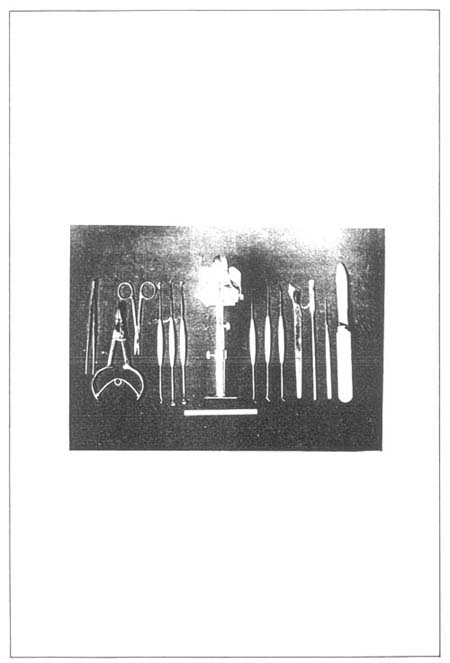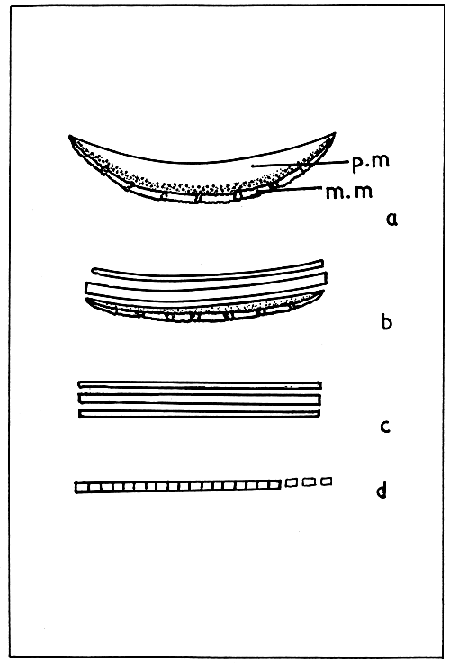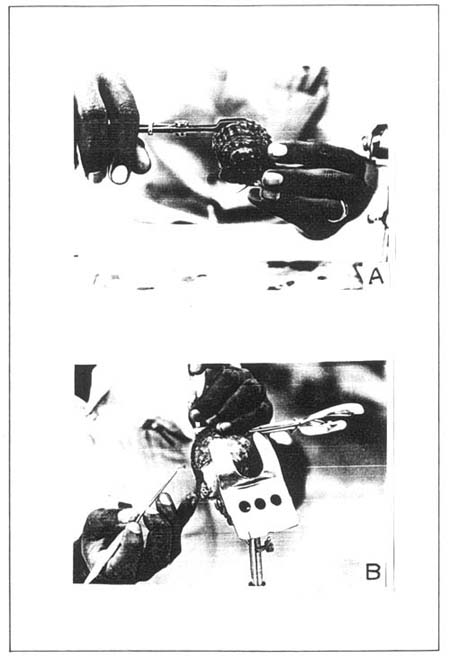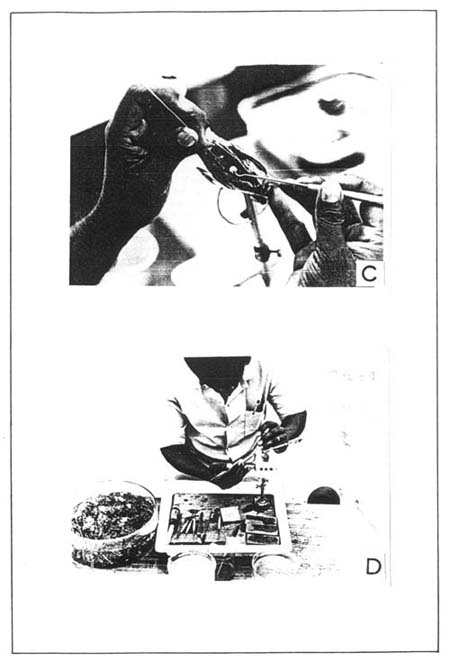The two items needed to induce the formation of a cultured pearl are a piece of mantle and a nucleus. The mantle piece, taken from a donor oyster, is grafted into the gonad of the recipient oyster, along with a spherical shell bead nucleus. The different steps followed in the operation are: (1) selection of oysters, (2) preparation of graft tissue, (3) conditioning of oysters, (4) pearl oyster surgery and (5) post-operation care.
A set of specially made surgical tools is used in the surgery (Plate VII). These instruments can be made to specification by any surgical instrument manufacturing company.
Knife
The knife has a blade 9 cm long and a wooden handle 11 cm long. The width of the blade is 1.2 cm at the base and 1.5 cm near the tip. The anterior portion of the blade is slightly curved corresponding to the curve of the oyster shell, so that the blade can be easily inserted between the two shells in closed condition. The blade is made by hand forging and finished by filing and grinding. The knife is used to open the unconditioned oysters by sharply cutting the adductor muscle without touching the mantle lobes.
Scissors
This is a pair of straight surgical scissors of 10 cm length. It is used for cutting a long and narrow strip of mantle from its edge. The cutting edges are sharp and the tips are finely ground so as to enable quick cutting of a strip before the mantle withdraws under the stimulus of contact.
Forceps
The forceps is usually 14 cm long. The two components are filed and ground and are provided with serrations and finely ground points at the tips. The material near the joint is ground to proper size to get required mild tension after due hardness is imparted. It is used to lift the mantle strip from the shell, to hold it while cleaning and trimming and to reverse the strip on the wooden block.

PLATE VII. Pearl oyster surgical instruments.
Spatula
The spatula is 17.5 cm long, with a round handle of 13 cm length and 4 mm diameter and a blade 4.5 cm in length and 8 cm in width. The required springiness is given to the blade by grinding and the edges are smoothened out. The spatula is used to remove dirt on the mantle strip and to smoothen the folds on it. It is also used to gently lift back the mantle, labial palps and gills of the oyster during surgery so that the foot and the main body are exposed.
Scalpel
The scalpel is flat and 17 cm long, the length of the blade portion being 3.5 cm. The scalpel is produced by forging from bar stock or blanked from sheet metal and the actual size and shape are obtained by filing and grinding. The instrument is then heat treated to get high hardness. The 2 cm broad cutting edge provided at the end has a delicate curve and is smooth and sharp. The scalpel is used for trimming the mantle strip on both edges, to remove unwanted tissue and to sharply cut the tissue into small bits of the required size. It is also used in place of scissors to cut strips from the mantle.
The second group of tools used in the actual operation are designed for the pearl culture industry operators. They are described below:
Oyster stand
The stand is used to hold the oyster in a stable position, so that the operator's hands are free to perform the surgery. It consists of two parts, the base and the clamp. The base consists of a wooden board, to which is screwed a metal square plate, 4.5 cm wide. A vertical tube of 15 cm in length and 1 cm inner diameter is welded to the basal plate. The tube has a collar at the top provided with a threaded hole for fixing a bolt to hold the shaft of the clamp tightly in position.
The clamp consists of two plates, the head-plate and a movable jaw. The head-plate is mounted on an adjustable tilting head supported by a shaft. The movable jaw is held against the head-plate by a spring. The front edges of the two plates form short, slightly curved lugs, which tend to follow the curve of the oyster shell and prevent lateral movement of the oyster. To the head-plate is fixed a curved rod, which passes through a hole in the shaft. A threaded hole and bolt are provided at this point to fix the rod in position. The plate assembly can be tilted from a vertical to a horizontal position according to the convenience of the operator. For fixing the oyster, the movable jaw is opened by applying finger pressure at the bottom of the plate and after the oyster is placed in position the pressure is released. The jaw holds the oyster firmly against the head-plate. The head-plate has a breadth of 5.3 cm and a height of 7.0 cm. The movable jaw is 5.5 cm broad and 8.5 cm high. The shaft is 11.5 cm long and its diameter is slightly less than 1 cm. The components are individually made to size and shape and are heat treated to sufficient hardness. They are then assembled to form the oyster stand.
Shell speculum
The shell speculum is used to keep the oyster open for the duration of the operation. The instrument is 14.5 cm long and consists of two components, which are made by forging from round bar stock to proper size and shape. Each component has a long straight portion and an arc. The two arms are fitted together by a male-female joint at about 5 cm from the tip. The top of the straight portion is flat and rectangular with rounded corners. The spring between the two arcs keeps the instrument in a closed position normally. A metal collar, which is provided around the straight arms, helps regulate the distance between the flat ends as desired. A maximum opening of 1.5 cm is obtained between the flat ends with the collar pushed to the bottom. This is about the distance between the two valves of the operable size oyster when the adductor muscle is in a fully relaxed condition under narcotisation. When the oyster partially opens its shells, the flat end of the speculum is inserted between the two valves. By gently closing the two arcs, the flat ends open and along with them also the shell valves. When the desired gap is obtained, the collar is slipped down to maintain the gap. The maximum possible opening between the shell valves differs from oyster to oyster.
Retractor
It is a slender, flat rod 15 cm in length, provided with a sharp bent hook at the tapered end. The retractor is used to hold the foot of the oyster in a stretched position during the operation.
Lancet-cum-graft lifting needles
There are three such needles. Each needle consists of an elongated spindle-shaped aluminium handle in the middle (6.5 cm long), with a lancet and a graft lifter, each 5.5 cm long, at the two ends. The lancet is a thin (2 mm) stainless steel tapered shank with its tip slightly curved and flattened to form an elliptical blade. The edge of the blade is rendered smooth and sharp. The graft lifter is similar to the lancet, but the tip is provided with a sharp, pointed spur. The lancet is used to make a sharp incision at the base of the oyster foot and to cut a channel through the tissues of the gonad up to the site chosen for nucleus implantation. The spurred tip of the needle is used to pick out the small graft tissue from the wooden block and to insert it into the site of implantation through the channel. The sizes of the cutting blade of the lancet and the spur are a graded series according to the size of the graft tissue to be lifted. The lancets and graft lifters are made to the desired shape and size by hand forging and finished by filing and grinding with abrasive wheels. They are polished to the required extent and fitted to the handle.
Nucleus-lifting needles
These are similar in construction to the needles described above, but are provided with hemispherical cups at both ends of the shanks. There are three such needles, each with two cups at the ends. The cups are of different dimensions to enable lifting of nuclei (spherical shell beads) of 2–8 mm diameter range. The cup shoe is initially drawn by hand forging and finished to dimensions by pressing with iron balls of proper size in the cold condition. Then the hemispherical cup is cut to the required size of slightly less than the diameter of the sphere and imparted a vacuum finish. The cup is moistened by dipping in seawater and made to touch the dry surface of the nucleus which immediately adheres to it. The cup end is inserted into the channel through the incision cut on the body of the oyster and the nucleus is placed in contact with the tissue graft. While withdrawing the needle, the nucleus is made to drop from the cup by a slight turn of the needle.
Spherical shell beads are used as nuclei to produce round pearls. These beads are prepared out of thick shells of other molluscs, usually freshwater mussels. These shells are imported into Japan from USA, where the freshwater mussels, popularly called pig-toe shell (Tritogonia), three-ridge shell (Pleurobema) and washboard shell (Megalonais), themselves known to produce pearls, occur in the tributaries of the Tennessee River. Alternatively, locally available thick molluscan shells which have a composition akin to pearl oyster, as for example the shell of the chank Xancus pyrum, can be used after studying the specific gravity of the material and other characteristics. Molluscan shell material is preferred due to phylogenic affinity, chemical composition, binding strength and heat resistance properties which are similar to those of the nacre. The shells are processed into spherical beads of different diameters, generally 2–7 mm for Pinctada fucata, through cutting, grinding, shaping and polishing using appropriate machines and tools. Dimensional accuracy, smooth finish and high polish are important factors. The beads should be cleaned and dried before use.
The factors to be considered in the selection of oysters are their weight, reproductive stage of development and overall health. A weight of 25 g or more is the ideal size for implantation, while 20 g oysters can be considered for implantation of smaller size nuclei, i.e. 2–3 mm in diameter. Fully matured oysters are not suitable, since during surgery the gametes tend to flow out and block the visibility of the implantation site so that proper orientation of the mantle piece and nucleus cannot be ensured. Therefore, oysters in the immediate post-spawning recovery phase or those in the early phase of gametogenesis should only be selected. This factor in turn decides the annual surgery period. In addition, the oyster should not suffer from polychaete blisters, sponge borings and trematode infection. The selected oysters should be cleaned and all the fouling organisms carefully removed.
The donor oysters do not have to be subjected to any conditioning process, which the recipient oysters have to undergo. Small pieces of the pallial mantle taken from the donor oysters are used as grafts for implantation (Fig. 6).
The donor oyster is cut open as follows:
Hold the oyster dorsal side down and the posterior end facing the technician.
Insert the curved end of oyster knife between the two valves at the posterior side.
Push the knife straight through the oyster until the knife tip reaches the anterior end.
Press the knife straight downwards to cut through the adductor muscle.
Separate the two valves by tearing the hinge, without disturbing the two mantle lobes. If disturbed, the lobes will shrink and cannot be used.
The steps involved in the removal of the mantle (marginal and pallial region) are given below:
Deal with one valve, with the adhering body tissue, at a time.
Expose the mantle lobes by gently brushing aside the gills with the tip of spatula. Care should be taken for the mantle not to shrink.
With the aid of the knife, starting from the posterior margin, cut the mantle tracing a curve up to the anterior margin (Fig. 6 A).
Using the forceps, lift the mantle gently and place the tissue on a soft, clean, moist wooden block without changing the side. At this stage the inner epithelium of the mantle is facing the technician.
Further steps in the preparation of graft tissues are as follows:
Gently stretch the tissue end to end.
With a wet sponge, gently wipe out all the mucus and dirt.
Use the graft knife to cut away the marginal mantle (this mantle is characterized by numerous folds and it is highly pigmented).
In the same manner cut away the inner muscular portion of the mantle on the opposite side.
Again wipe the mucus and dirt with a wet sponge.
Holding one end, lift the mantle ribbon, reverse the side (top to bottom) and place it on the block. Now the outer epithelium is facing the technician.
Wipe the mucus and dirt softly without causing damage to the outer epithelial layer.
Trim the margins on either side until a mantle ribbon of about 3 mm width is obtained (Fig 6 B and C).
Remove all the dirt and mucus from the wooden block. If necessary, transfer the mantle ribbon to a new block without changing sides.
Use the graft knife to cut the ribbon into small pieces (2–3 mm). The size of each piece has to be in proportion to the size of the nucleus (Fig 6 D).
With the use of a soft brush smear the mantle pieces with a highly diluted solution of water-soluble eosin.
Keep the tissues moist until they are used within about 30 minutes.
Precautions
Care should be taken to ensure that the knife does not injure the palm of the technician while inserting it between the valves of the oyster.
Use only clean, sterilised, filtered seawater throughout the operation.
All instruments must be washed and sun dried before their use.
Sponges must be clean and moist. Different sections of the sponges must be used for each wiping operation.
Wooden blocks must be clean, smooth and moist all the time.
Shrunken mantles should not be used due to difficulty in handling them.
Natural conditioning is ideal and inexpensive, however it can be practised only in regions where there is stratification of seawater temperature, as well as sharp difference in food availability. This method works well in the sea conditions in Japan. Using the thermal differences, the oysters are spawned in the upper water layers which have a relatively high temperature. With the loss of the stored energy, due to spawning, the weakened oysters are further subjected to starvation by placing them at depths where phytoplankton production is low, in order to reduce their metabolic rate. Such conditioned oysters can be readily used in surgery.
Where such techniques do not work, such as in Indian waters, chemical conditioning is resorted to. Menthol crystals are sprinkled over the seawater in the tanks in which the oysters are placed. In about 60–90 minutes, the oysters become narcotised and relax their adductor muscles and open the valves. The time of response varies with the water temperature, however once narcotised the oysters become almost non-responsive to touch. The conditioned oysters are usually operated within the next 10 to 15 minutes as prolonged exposure causes swelling of tissues, copious secretion of mucus and mortality. A duration of about 30–40 minutes after response is the safe limit, and therefore the pearl oysters should be treated in batches.

FIGURE 6. Steps in graft tissue preparation. (A) mantle tissue when removed from an oyster (p.m.= pallial mantle and m.m.= marginal mantle); (B) trimming of the margins to remove marginal mantle and inner muscular tissue; (C) further trimming to obtain ribbons of pallial mantle; and (D) cutting of the ribbon into small sections.
The number of nuclei to be implanted in one oyster is usually decided before the operation. Single and double implantations are common while multiple implantations are usually carried out when large numbers of small pearls of about 2–3 mm are required. Large diameter nuclei, in the range of 6–7 mm, are generally used in single implantation, one nucleus in each oyster. Nuclei with diameters ranging from 4–6 mm are used for double implantation, a large and a small one in each oyster. Nuclei with diameters of 2–3 mm are generally used in multiple implantations, five or more nuclei in one oyster.
The best site for nucleus implantation is the gonad, particularly in its ventral portion. Single implantation is always done at this site. In double implantation, the above site is used for the larger nucleus while a site in the dorsal region of the gonad, close to the hepato-pancreas, is used for the smaller nucleus.
The steps involved in pearl oyster surgery are as follows:
Insert the end of the speculum through the posteroventral corner of the oyster and open it by sliding backward the gap-regulator ring (Plate VIII A). Attention should be paid not to open the oyster too much as the adductor muscle may snap and kill the oyster.
Mount the oyster with the speculum on the clamp. The oyster should be placed correctly between the two plates of the clamp so that it does not slip. The speculum is now towards the left-hand side of the technician.
Hook the tip of the foot with the needle with the left hand and gently pull it so that the base of foot is slightly elevated. Hold the needle in position until the operation is completed.
With the oval knife end of the incision-cum-grafting needle in the right hand, make a sharp incision at the base of the foot. Through this opening, passing the needle below the outer skin, steadily and gently cut a passage through the gonad connective tissue up to the site of implantation. Gently withdraw the needle.
Pick a piece of graft tissue, already on the block, with the tip of the needle (same needle as above but reversed) and gently insert it through the passage cut in the gonad. On reaching the site, gently deflect the needle and allow the graft tissue to drop. Withdraw the needle. Now the outer epithelium of the graft tissue is facing the passage (Plate VIII B).
Lift a nucleus with the moistened cup end of the appropriate nucleus-implanting needle and gently insert the nucleus through the gonad (Plate VIII C and D). On reaching the site, deflect the needle gently so that the nucleus drops. At this stage the nucleus must be in contact with the outer epithelium of the mantle tissue which was grafted into the gonad by the preceding step. Withdraw the needle gently through the passage.
Smoothen the incision with the cup end and let the two margins of the incision come in contact. The nucleus implantation operation is now over.
Remove the oyster from the clamp, withdraw the speculum by slipping the gap-regulator ring forwards and place the oyster in clean seawater.
Precautions
Before and after use, wash the instruments in clean seawater.
Adjust the pressure on the foot in a way that the foot does not get torn while pulling it with the needle hook.
The incision should be a sharp cut and of the required length for the size of nucleus to be inserted. If the incision is too large the nucleus may slip out. If there is too much tear of tissues, do not proceed. Place the oyster back in fresh seawater and return to the farm for future use.
While cutting the passage through the gonad, if there is copious flow of gametes, do not proceed but return the oyster to the farm.
Do not cause damage to the vital organs such as stomach, intestine and heart during the surgery.
The orientation of graft tissue (outer epithelium) and nucleus should be correct.
Skill and patience are the key factors for a successful operation.

PLATE VIII. Implantation of a pearl oyster. (A) Opening of the oyster valves and (B) Insertion of the graft tissue.

PLATE VIII. Cont'd. Implantation of a pearl oyster. (C) Implantation of the nucleus, and (D) General view of oyster surgery.